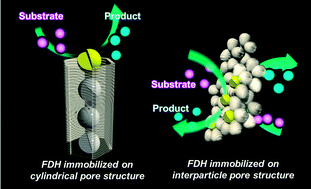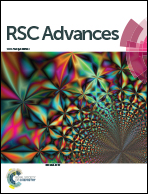Interparticle mesoporous silica as an effective support for enzyme immobilisation†
Abstract
Mesoporous silica materials with cylindrical pores (MPSC) and interparticle pore structures (IPMPS) were synthesized by typical sol–gel methods, and their structural properties were characterized. The enzyme immobilised on IPMPS exhibited higher specific reactivity because of an improvement in the substrate affinity of the enzyme immobilised on the pore spaces of the IPMPS support. Fourier transform infrared and circular dichroism spectroscopy indicated that the highly ordered structure of formaldehyde dehydrogenase (FDH) is not altered by binding to IPMPS and MPSC surfaces. Interestingly, after 10 repeated reactions, FDH immobilised on IPMPS exhibited a residual activity higher than that of FDH immobilised on MPSC. The cycle performance of the enzyme immobilised on MPSC decreased because of support aggregation by the released enzyme. Meanwhile, IPMPS has a high-intensity surface electrical charge that is highly dispersible in the presence of enzymes. In addition, enzymes that were inactive because of being buried inside mesopores are quantitatively determined. The dependency of the activity of FDH immobilised on IPMPS and MPSC as a function of substrate (formaldehyde) concentration was also evaluated to determine the potential application of these materials as biosensors. Formaldehyde concentrations of 3.0–500 μM could be detected using FDH immobilised on the IPMPS support.


 Please wait while we load your content...
Please wait while we load your content...